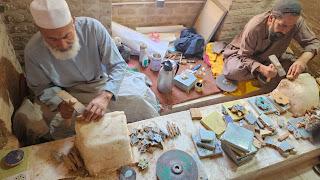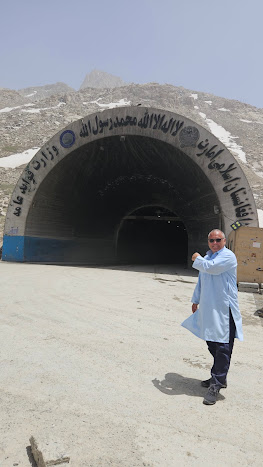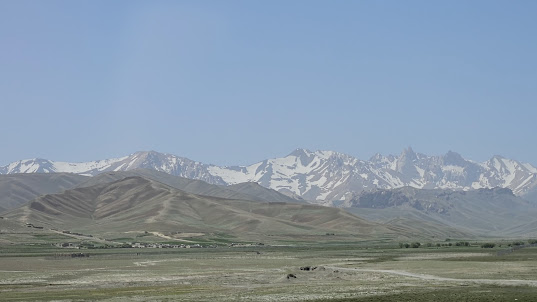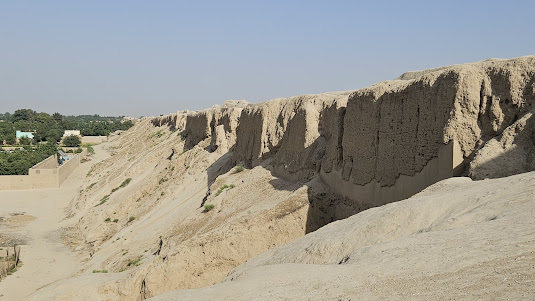After the drive back to Kabul from Bamiyan we spent the night at the Khyber Hotel then we were off again first thing the next morning on another Ariana Airline domestic flight, this time to Herat, a town with more religious historical importance that any city in Afghanistan. I can also now confirm that these Ariana Airlines planes need a bit of fine tuning, well maybe more than a bit. On arrival to Herat a piece of the overhead luggage rack broke and hung there, ready to decapitate anyone who dared to move and nobody blinked. Not my airline and this was the last of my internal flights but get me off this death trap!!
 |
| Me, David, Abbas |
 |
| Taliban flag on the Citadel |
 |
| Welcome to Herat |
A quick photo at the Herat sign and then over to Registration which was as easy as handing over my passport to a guy who took it, and about 4 others into a room and shut the door. He returned about 5 minutes later, smile and said "enjoy Herat". The inconsistencies in this country are fun to watch. However here we were, in Herat. We met our guide and driver from the first two days, Abbas and Mohammad and off we went, into the second part of my journey.
Abbas is from Herat and he was excited to share stories of his growing up. Mohammad had limited english but smiled and would blurt out a new learned word every once in a while and we would cheer him on, his smile and pride glowing.
 |
| A cool shot from the Mosque |
 |
| The Citadel of Alexander the Great |
We headed to the hotel to drop off our bags and clean up a bit. When Abbas banged on the metal door to what looked like a garage I was a bit concerned that the hotel was not up to the decent standards we had be given. Once through and past the heavily armed but friendly security guard and then up the elevator to the reception, well the Sadaf International Hotel was just fine. The first thing they offered was "free laundry service" which I took advantage off.
 |
| Old Artisans |
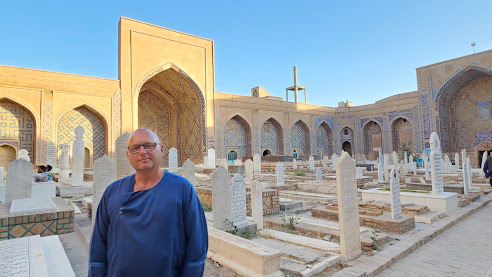 |
| Cemetery |
 |
| 85 year old man eager to share his stories |
Our first stop was the Malan Bridge that was originally built in 1100 AD. It has since been rebuilt a few times and Abbas made a good point when he said, "yes, we can say it was built in 1100 AD but really it was built in the 1980s after the Russians left, so it does not have much history." Insightful young man that Abbas.
We then set off to Jami Masjid of Herat, or the Central Blue Mosque of Herat which was built in 1200 AD. These ancient Muslims sure loved their blue tiles. It was then a short drive to The Citadel of Herat was built by Alexander the Great in 330 BC but destroyed by freaking Genghis and was rebuilt a few times over the years. The Mosque was a beauty and we spent quite a bit of time wandering around taking photos, as you do. At the Citadel we did the same, however the three of us found a spot on the roof and sat in the shade. Abbas talked about the history and beauty of the Citadel, again it lost some of it's luster through rebuilds, but it was impressive, nonetheless. Our conversation quietly drifted to local life in Afghanistan and the real situation that Abass and everyone faces, without any gory details. We chatted for the better part of two hours, only stopping when a random tourist or local came nearby...remembering to "never trust anyone."
Now came something incredibly bizarre, the Womans Market. No, not a market to find a bride, but a market dedicated to woman and it was busy. HOWEVER, it did not take long to find members of the Taliban standing guard and any woman who did not have the proper clothing on, or dare to not have her arms fully covered we given a quick "wack" with a stick. This was no video game. I was also told to be care not to bump into any woman because they could scream and accuse me of touching them and my immediate response was "Abbas WTF are we doing here if that is the case?" David, the poor guy was clueless so I suggest we leave after about 20 minutes. I mean it was incredible to experience the absolute mayhem of real life in Herat, but there is a line that I was not prepared to cross. I suggested lunch and off we went.
Day two brought some new insights. After breakfast we went into Old Herat (Charsug) then to the 15th Century Musalla Complex and Minarets. Repeating myself, the ancient history just hangs in the air and drips off these buildings. Then it was off to the Shrine of Khwaja Abdullah Ansari who was a prominent poet, philosopher and Sufi 1000 AD which was a safe space for woman during the Republic years of Hamid Karzai of 2002 to 2014, which fell between the Taliban Government years. Now in disrepair we still managed to pick ripe plumbs' and blackberries from the trees in the gardens.
The wake up for me was to discover that there "were" 5 Jewish synagogues and a working bathhouse in the old section of Herat. After WW2 many jews came to Afghanistan and started a working and thriving community. However, as you can suspect, they were forced out during the rise of the Taliban, thanks to the Soviet invasion of 1979. Two of the synagogues became schools, two were destroyed and we visited the last remain one that was intact. It was very odd to see the Star of David in a Radical Muslim country.
Finally, we went to an old "way station" that was 300 years old. This was where weary travelers and traders would find a place to stable their horses or camels, plus find a room, food and entertainment for themselves. I stood and had a bit of a daydream about the hustle and bustle of the place. Mostly abandoned now but a few craftsmen and artisans have setup shops in some of the rooms. We were also introduce to a few old guys who have worked here for over 70 years. They did not work now but would come everyday to just hang around, drink tea and chat excitedly with the random tourists that showed up. These guys have lived through some sh** and I was happy to listen to their stories, as translated by Abbass.
Herat was all about the heart of religious history of Afghanistan. It is diverse, complex and mostly unknown in the west. It is Alexander the Great, Genghis Khan and a more relaxed view of the world, although held in secret.
.heic)



